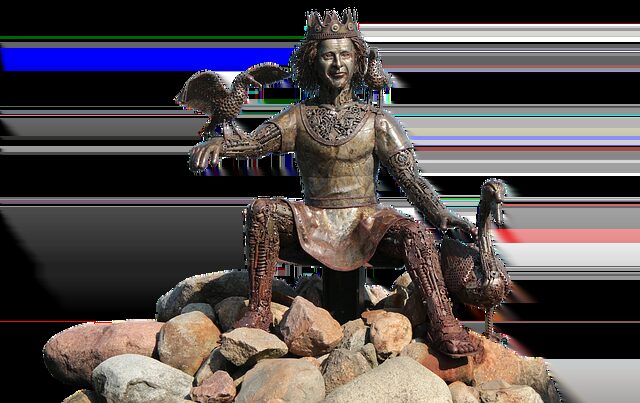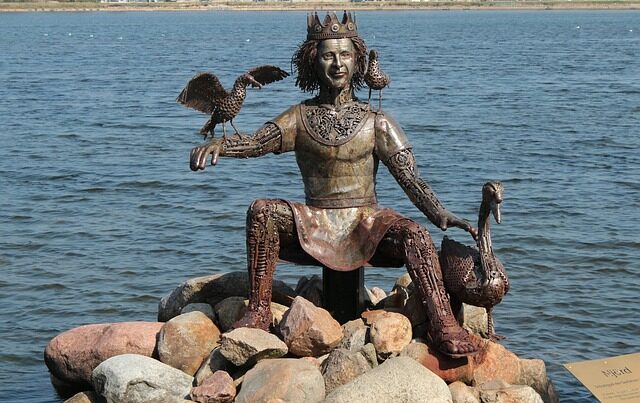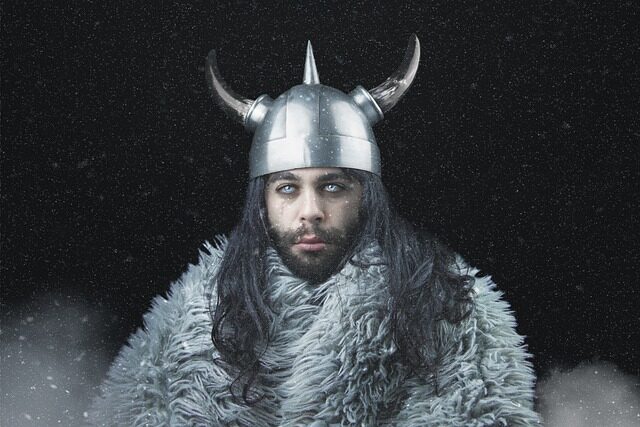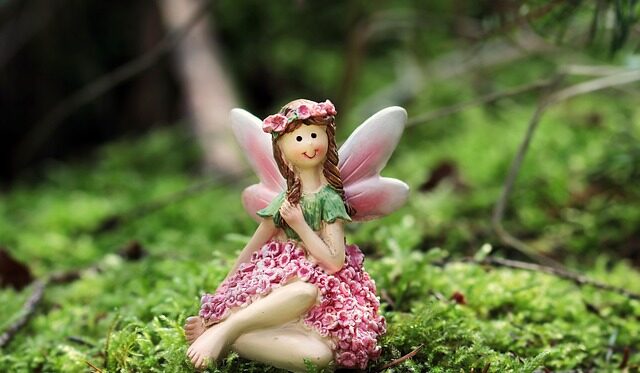The ancient narratives of the North Germanic tribes come alive in the tales of Norse mythology, a saga-filled realm where gods and goddesses, giants, and creatures dwell. At the heart of these myths are the powerful deities that have captivated the imagination for centuries, leading to a rich legacy that endures in modern culture.
Exploring the history of the Norse gods is akin to unearthing a cultural treasure trove, full of profound beliefs, epic battles, and a vision of the cosmos that is as fascinating as it is complex. Let’s embark on a journey through the fabled world of Odin, Thor, Freyja, and their kin.
The Origins of Norse Mythology
Delving into the history of the Norse gods and goddesses, we encounter the ethereal realm where the cosmos was said to have been birthed. The creation myths of Norse mythology speak of a time when fire and ice converged, leading to the emergence of the primeval giant Ymir, from whom the world was created.
These foundational narratives set the stage for the pantheon of gods who would inhabit the Nine Worlds and interact with humanity. Their tales were passed down through oral traditions and later captured in medieval texts like the Prose Edda and the Poetic Edda.
Central to understanding these origin stories is recognizing how they reflect the beliefs and values of the Old Norse people, emphasizing themes of creation, destruction, and rebirth.
The gods themselves are often seen as personifications of natural elements and societal principles, integral to the lives and worldview of the Viking and Germanic tribes.
Concerns such as honor, bravery, and the inevitability of fate were woven into these early tales, illustrating the Norse people’s perspective on life and the universe.
What Is the History of the Norse Gods?
The pantheon of Norse deities is vast and varied, with each god and goddess serving distinct purposes within the mythology. Odin, the Allfather, is often at the forefront as the chief god, a figure of wisdom and war.
Thor, with his mighty hammer Mjölnir, is the protector of mankind and the god of thunder, while Freyja, the goddess of love and fertility, is also a formidable warrior and leader of the Valkyries.

Their stories are not mere tales of divine adventure but also serve as allegories for the human condition, exploring themes of power, love, sacrifice, and the search for knowledge.
The intersecting tales of these deities form a complex network of narratives, each adding to the overarching story of the gods’ interactions with the giants, the world of men, and their eventual downfall during Ragnarök.
It is through these interconnected stories that we gain insights into the values, fears, and aspirations of the Norse people, with the gods acting as both creators and destroyers within their mythology.
How Many Norse Gods and Goddesses Were There?
While the exact number of Norse gods and goddesses is uncertain, as the mythology evolved over time and varied by region, there are several key figures who are consistently revered across different accounts.
- Odin – The all-knowing ruler of the gods
- Thor – The thunder god and defender of humanity
- Freyja – The goddess of love and war
- Freyr – The god of fertility and prosperity
- Loki – The trickster god of chaos and change
- Heimdall – The watchman of the gods and guardian of the Bifröst bridge
- Balder – The beloved god of light and purity
This is just a sampling of the larger Norse pantheon, which includes numerous other deities, each with their own domain, personality, and significance within the mythology.
Additionally, there are various other beings like the jötnar (giants), dwarves, and elves that play crucial roles in the gods’ sagas. The expansive cast of characters within Norse mythology speaks to the rich tapestry of stories that were integral to ancient Scandinavian culture.
What Are the Powers of the Norse Gods?
The Norse gods and their powers are as diverse as they are dramatic. They wield control over various aspects of the natural and supernatural worlds.
Odin is not only the king of the gods but also the god of wisdom, poetry, and death. He sacrificed an eye for knowledge and is accompanied by his ravens, Huginn and Muninn, who bring him news from all over the world.
Thor is revered for his immense strength and his ability to control the weather, particularly thunder and lightning, embodying the raw power of nature.

Freyja commands magic and divination, having taught seidr, the Norse form of sorcery, to the other Aesir gods.
Their abilities not only emphasize their dominion over particular realms but also underline the connection the Norse felt to the environment and the unseen forces that guide fate and fortune.
Such powers are often depicted in the artifacts and inscriptions left behind by the Norse people, which provide glimpses into the religious practices and beliefs that centered around these divine beings.
Exploring the Norse Gods and Their Legends
The stories of the Norse gods are myriad, ranging from the creation of the cosmos to the daily lives of the deities.
One such legend tells of how Thor once disguised himself as a bride to retrieve his stolen hammer, Mjölnir, showcasing the gods’ cunning and the high stakes of their adventures.
Loki’s mischief and the consequences of his actions are a recurring theme, illustrating the complex nature of fate and the interconnectedness of all beings within the Norse cosmos.
The tales of the gods often intersect with those of heroes and mortals, as seen in the many Viking sagas, which reveal the integration of divine influence in human affairs.
The moral and ethical lessons within these legends continue to resonate, reflecting the enduring impact of Norse mythology on literature, art, and popular culture.
Symbols such as Thor’s hammer and Odin’s spear have transcended their mythological origins to become icons of strength and wisdom in various forms of modern expression.

What Role Did Yggdrasil Play in Norse Mythology?
Yggdrasil, the immense ash tree that stands at the center of the Norse cosmic order, is arguably one of the most significant symbols of Norse beliefs. It is known as the World Tree, connecting the Nine Worlds and serving as a metaphor for the interconnectedness of all life.
Its roots and branches reach into various realms, from the heavenly abodes of the gods to the misty depths of Hel, the land of the dead. This all-encompassing nature of Yggdrasil reflects the Norse understanding of the universe’s complexity and the cycle of life and death.
The significance of Yggdrasil in Norse beliefs cannot be overstated; it is a representation of stability, growth, and the eternal cycle of renewal. The tree’s resilience and its role as the axis mundi underscore the Norse worldview’s emphasis on endurance and the constant flow of existence.
Legends surrounding Yggdrasil often include the creatures that inhabit it, such as the dragon Níðhöggr gnawing at its roots, and the eagle perched atop its highest branch, highlighting the dynamic and sometimes perilous nature of the cosmos.
The reverence for Yggdrasil is evident in the way it permeates Norse mythology, serving as a focal point for the narratives that define the gods and their world.
The Significance of Ragnarök in Norse Beliefs
Ragnarök, the prophesied end-of-the-world event, looms large in Norse mythology. It is a series of cataclysmic occurrences, including battles among the gods, natural disasters, and the ultimate destruction of the world, followed by its rebirth.
Figures like the fearsome wolf Fenrir and the Midgard Serpent play pivotal roles in this apocalyptic tale, illustrating the inevitable cycle of chaos and renewal that governs the Norse universe.
The idea of an end that precedes a new beginning is a profound reflection of the Norse philosophical outlook on life, death, and the impermanence of existence.
Despite its grim portrayal, Ragnarök is also a narrative of hope, as it suggests the emergence of a new world from the ashes of the old, with the potential for new life and new stories.

This momentous event encapsulates the Norse belief in the interconnectedness of all things, the power of destiny, and the enduring nature of the cosmos, even in the face of destruction.
As we explore the rich landscape of Norse mythology, it is clear that the legends and gods continue to capture our collective imagination, offering timeless insights into the human experience.
To further enrich your knowledge of this fascinating mythology, watch this intriguing video on one of the key figures in Norse mythology:
In conclusion, the history of the Norse gods is a complex web of tales and beliefs that offers a window into the worldview of the ancient Norse people. From the creation of the cosmos to the final battle at Ragnarök, the gods and their sagas embody themes that are universal and enduring, leaving a legacy that continues to influence and inspire to this day.

